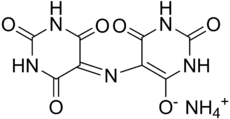Murexide
 From Wikipedia the free encyclopedia
From Wikipedia the free encyclopedia
 | |
 | |
| Names | |
|---|---|
| IUPAC name Ammonium 2,6-dioxo-5-[(2,4,6-trioxo-5-hexahydropyrimidinylidene)amino]-3H-pyrimidin-4-olate | |
| Other names Purpuric acid ammonium salt | |
| Identifiers | |
3D model (JSmol) | |
| ChemSpider | |
| ECHA InfoCard | 100.019.334 |
| EC Number |
|
PubChem CID | |
| UNII |
|
CompTox Dashboard (EPA) | |
| |
| |
| Properties | |
| C8H8N6O6 | |
| Molar mass | 284.188 g·mol−1 |
| Density | 1.72 g/cm3 (hydrate of ammonium salt) |
Except where otherwise noted, data are given for materials in their standard state (at 25 °C [77 °F], 100 kPa). | |
Murexide (NH4C8H4N5O6, or C8H5N5O6·NH3), also called ammonium purpurate or MX, is the ammonium salt of purpuric acid. It is a purple solid that is soluble in water. The compound was once used as an indicator reagent.[1] Aqueous solutions are yellow at low pH, reddish-purple in weakly acidic solutions, and blue-purple in alkaline solutions.
Preparation
[edit]Murexide is prepared by treating alloxantin with ammonia to 100 °C, or by treating uramil (5-aminobarbituric acid) with mercury oxide.[2] It may also be prepared by digesting alloxan with alcoholic ammonia.
History
[edit]Justus von Liebig and Friedrich Wöhler in Giessen, Germany, had investigated the purple product, murexide, obtained from snake excrement in the 1830s, but this was not an abundant raw material, and a method of using it as a dyestuff was not established at that time.[3] In the 1850s, French colourists and dye-producers, such as Depoully in Paris, succeeded in making murexide from abundant South American guano and of applying it to natural fibres. It was then widely adopted in Britain, France and Germany.
Use
[edit]Murexide is used in analytical chemistry as a complexometric indicator for complexometric titrations, most often of calcium ions,[4] but also for copper, nickel, cobalt, thorium and rare-earth metals. It functions as a tridentate ligand.[1]
Its use has been eclipsed by calcium-ion selective electrodes.
References
[edit]- ^ a b Martin, Raymond L.; White, Allan H.; Willis, Anthony C. (1977). "Structural Studies in Metal–Purpurate Complexes. Part 1. Crystal Ctructures of Potassium Purpurate Trihydrate and Ammonium Purpurate Monohydrate (Murexide)". J. Chem. Soc., Dalton Trans. (14): 1336–1342. doi:10.1039/DT9770001336.
- ^ Some information on the chemist W. N. Hartley is available here Archived 2013-05-26 at the Wayback Machine.
- ^ Peter J. T. Morris; Anthony S. Travis (November 1992), "A History of the International Dyestuff Industry", American Dyestuff Reporter, 81 (11), archived from the original on June 11, 2007
{{citation}}: CS1 maint: unfit URL (link) - ^ Lewis, Michael J. (2011). "The Measurement and Significance of Ionic Calcium in Milk - A review". International Journal of Dairy Technology. 64: 1–13. doi:10.1111/j.1471-0307.2010.00639.x.
This article incorporates text from a publication now in the public domain: Chisholm, Hugh, ed. (1911). "Murexide". Encyclopædia Britannica. Vol. 19 (11th ed.). Cambridge University Press. p. 36.